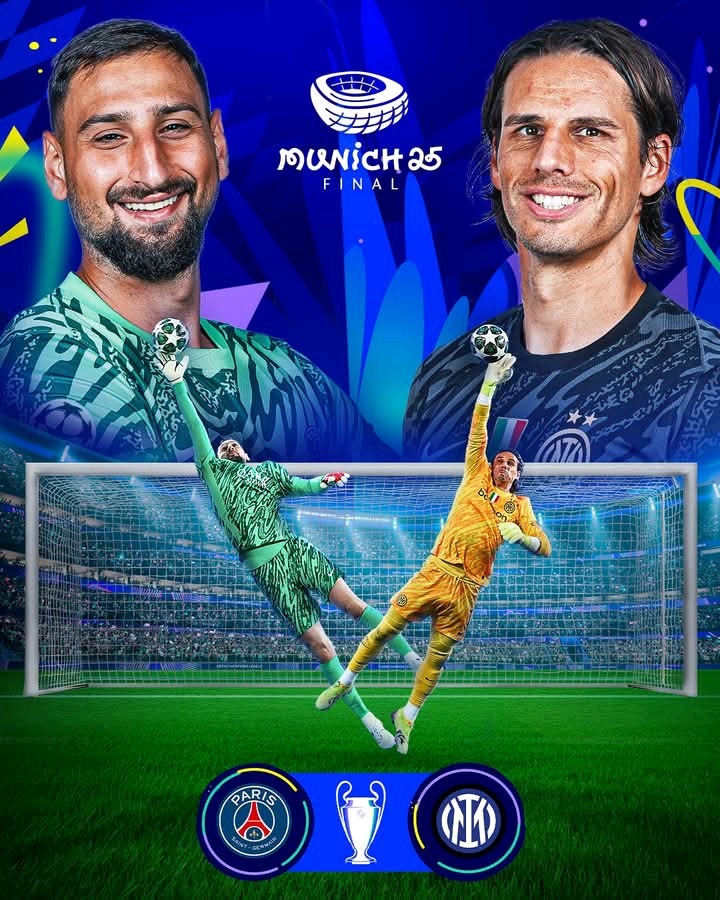The 2025 UEFA Champions League Final pits Paris Saint-Germain against Inter Milan in what promises to be a clash of ideologies, execution, and tactical discipline. Luis Enrique’s PSG will look to dominate with fluid, possession-based football, while Simone Inzaghi’s Inter Milan will aim to frustrate and counter with deadly precision. As both managers prepare for this high-stakes encounter, the tactical nuances will likely define who lifts the trophy.
PSG’S FLUIDITY, VERSATILITY AND HIGH PRESSING
Formation: 4-3-3 transitioning into 3-2-5 in possession
Luis Enrique has molded PSG into a more tactically mature and versatile team than in previous seasons. His setup is rooted in high-possession principles reminiscent of his Barcelona days, but he’s added flexibility, especially when defending a lead or dealing with transitions.
When PSG are in possession, their 4-3-3 morphs into a 3-2-5. Achraf Hakimi pushes high to join the attack, while Mendes tucks in to form a back three alongside Marquinhos. The midfield duo of Vitinha and Fabián Ruiz sit deeper to support build-up and recycle what possession.
PSG rely on wide overloads and quick ball circulation to stretch defenses. Up front, Kvicha Ousmane Dembélé interchange constantly, pulling defenders out of shape. Dembélé, in particular, will look to isolate Francesco Acerbi in wide areas- an area of concern for Inter.
II. INTER MILAN’S STRUCTURED DEFENSIVE BASE AND DIRECT TRANSITIONS
Formation: 3-5-2 transitioning into 5-3-2 without the ball
Simone Inzaghi’s Inter Milan are tactically astute and difficult to break down. Their shape is rigid out of possession, but the moment they win the ball, their transitions are brutally effective.
Inter’s three center-backs; Benjamin Pavard, Alessandro Bastoni, and Francesco Acerbi—hold the line with support from wing-backs Federico Dimarco and Denzel Dumfries. Hakan Çalhanoğlu serves as the deep-lying playmaker, flanked by Nicolò Barella and Henrikh Mkhitaryan, who shuttle up and down to press or link play.
The front two of Lautaro Martínez and Marcus Thuram combine intelligence, physical presence, and explosive movement. Lautaro often drops into the half-space to pull a defender with him, creating vertical lanes for Thuram or Dumfries to exploit.
Inzaghi’s men typically allow the opposition to have the ball, especially in the middle third, but spring into life once the wing-backs recover possession. They are comfortable absorbing pressure and launching fast, targeted counters that go from back to front in seconds.
III. KEY INDIVIDUAL MATCHUPS
Francesco Acerbi vs Ousmane Dembélé
Acerbi has struggled historically against agile, off-ball movers rather than classic No.9s. Dembélé’s drifting movements and direct dribbling could drag Inter’s left side into disarray if not managed properly. Expect extra cover from Bastoni and Çalhanoğlu in that zone.
Marcus Thuram vs Marquinhos:
Thuram thrives on chaos. If Inter can draw PSG’s defensive line high, Thuram’s runs into channels may test Marquinhos’ timing and recovery pace. One misstep and Inter could have a breakaway on goal.
Lautaro Martínez vs Lucas Beraldo:
Lautaro’s ability to drop between the lines and find pockets of space will force Beraldo to make quick decisions. Beraldo’s lack of experience at this level could be exposed if Lautaro times his movement and combines sharply with midfield runners.
Midfield Triangles:
Inter’s midfield of Çalhanoğlu, Mkhitaryan, and Barella will be tasked with disrupting PSG’s rhythm. Vitinha and Ruiz must avoid being overrun, while Neves freedom to join attacks will depend on how much time and space he’s afforded.
Denzel Dumfries vs Nuno Mendes:
Dumfries’ aerial presence and physicality could test Mendes, especially during set-pieces or deep crosses. Mendes, in turn, is lightning-quick and will look to exploit space behind Dumfries when Inter push high.
IV. FORMATION FLUCTUATIONS AND GAME STATE TACTICS:
Both teams are capable of shifting systems during play.
PSG have shown they can sit in a 4-4-2 mid-block when under pressure, especially when protecting a lead. Dembele and Kwicha can become a front two while Dembele also drops into midfield to help out defensively.
Inter may move into a 3-4-1-2 in possession, with Çalhanoğlu pushing up and Barella playing closer to Lautaro as a secondary runner. This shape also allows Dimarco and Dumfries to stretch the pitch horizontally.
Should PSG fall behind, Enrique might introduce Bradley Barcola or Gonçalo Ramos, switching to a more aggressive 4-2-4. Inzaghi, if chasing a result, might swap a midfielder for Davide Frattesi or push Bastoni higher to initiate overlapping runs on the left.
V. MENTALITY AND SQUAD DEPTH:
Inter arrive with more European final experience in recent years, having faced Manchester City in 2023. Their evolution from a team overwhelmed by the occasion to one brimming with self-belief could prove decisive.
PSG, while individually talented, remain somewhat reliant on their starting XI. The drop-off in midfield and defense beyond the first choice is notable. In contrast, Inter can bring on players from the bench to win.
This final isn’t just about two clubs vying for Europe’s biggest prize—it’s a tactical war between possession and pragmatism, speed and shape, chaos and control. Luis Enrique’s PSG will look to impose their identity through the ball, while Simone Inzaghi’s Inter will aim to steal the show with surgical precision and mental fortitude.
If PSG’s structure holds and their stars click, they have the firepower to overwhelm. But if Inter are allowed to lure them into their trap and strike on the counter, it could be another glorious night for Italian football.
The winner will be the side that adapts better to the other’s strengths without losing sight of its own.
Should we send you latest update about your favourite sports and team?
Enter you email in the box below and hit the subscribe button to join our teaming 876+ sports community.
